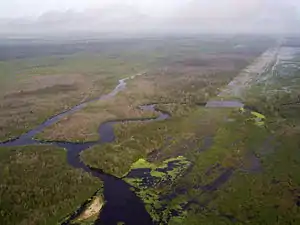
The restoration of the Everglades is an ongoing effort to remedy damage inflicted on the environment of southern Florida during the 20th century. It is the most expensive and comprehensive environmental repair attempt in history. The degradation of the Everglades became an issue in the United States in the early 1970s after a proposal to construct a jetport in the Big Cypress Swamp. Studies indicated the airport would have destroyed the ecosystem in South Florida and Everglades National Park. After decades of destructive practices, both state and federal agencies are looking for ways to balance the needs of the natural environment in South Florida with urban and agricultural centers that have recently and rapidly grown in and near the Everglades.
In response to floods caused by hurricanes in 1947, the Central and Southern Florida Flood Control Project (C&SF) was established to construct flood control devices in the Everglades. The C&SF built 1,400 miles (2,300 km) of canals and levees between the 1950s and 1971 throughout South Florida. Their last venture was the C-38 canal, which straightened the Kissimmee River and caused catastrophic damage to animal habitats, adversely affecting water quality in the region. The canal became the first C&SF project to revert when the 22-mile (35 km) canal began to be backfilled, or refilled with the material excavated from it, in the 1980s. (Full article...)